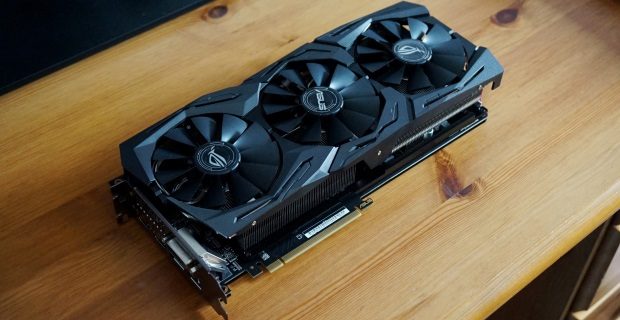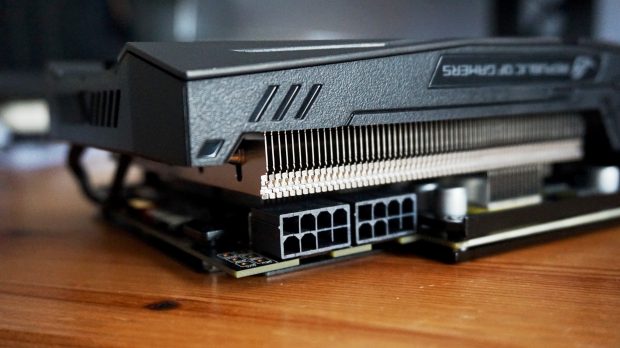
As the great graphics card mining crisis rumbles on, selecting a time to improve your PC has grow to be a minefield of inflated costs and overblown mark-ups – and nowhere has this been felt extra keenly than AMD’s new Radeon RX Vega 56 card and its massive brother, the Radeon RX Vega 64.
Whereas the RX Vega 64 targets the Nvidia GeForce GTX 1080 (our present best graphics card for 4K gaming), the RX Vega 56 takes purpose on the Nvidia GeForce GTX 1070. That is, a superb graphics card for 2560×1440 resolutions with ambitions of pushing into the 4K area with a few compromises. And but their respective costs couldn’t be extra totally different, with the most cost effective GTX 1070 at present costing around £500 / $665, whereas the poor previous RX Vega 56 will set you again at least £750 / $750. The easily-parsable Asus Radeon RX Vega 56 ROG Strix OC Gaming model I’ve received right here calls for much more, too, with costs at time of writing sitting lamentably out of attain across the £840 / $900 mark.
This instantly places the RX Vega 56 on the again foot, no matter which make you go for, however assuming all the things begins settling down in some unspecified time in the future sooner or later (and good gravy I hope they do), I’m going to disregard costs for the second and simply deal with whether or not it’s only a good graphics card. Capice? Capice. Let’s get to it.
So what makes the Asus so high quality and dandy and price that massive previous premium over lesser Vega 56 playing cards? Well, very like the ROG Strix OC model of the RX Vega 64 we examined not that way back, the ROG Strix OC Vega 56 comes with 8GB of High Bandwidth Memory 2 (HBM2), which makes use of stacked reminiscence to make all the things sooner and extra environment friendly, and a trio of IP5X mud protected followers. This means it ought to theoretically last more and be much less more likely to get clogged up with blankets of gunge in a few years time.

As its identify implies, it additionally has overclocked cores, giving its base clock pace a small bump from 1156MHz as much as 1297MHz and its increase clock pace a nudge from 1471MHz as much as 1573MHz. You get Asus’ fancy RGB tech, Aura Sync, as nicely so you may colour-code your card to match your suitable Asus motherboard, mouse and keyboard, and also you additionally get an honest number of ports, together with two HDMI 2.zero outputs (useful should you’re a VR cybergoggles proprietor), two DisplayPort 1.four outputs and one DVI-D output.
The Asus continued to impress when it got here to enjoying some precise video games, too. First up within the testing area was fancy costume simulator Hitman, and goodness what a convincing efficiency. Agent 47 positively glided by the Parisian vogue crowds at 1080p and 1440p on Ultra high quality settings, with the body charge repeatedly hitting a median of a minimum of 80fps at each resolutions in its built-in benchmark device. 4K wasn’t a lot hassle for it on Ultra both, with a formidable common of round 51fps.
Doom, likewise, didn’t put a foot incorrect, with the RX Vega 56 dealing with all three resolutions on Ultra with out breaking a sweat. I didn’t take pleasure in a benchmark device, however the Vega 56 was virtually actually hitting a minimum of 60fps throughout the board once I ran by the primary massive firefight on the UAC, with nary a dip even at 4K.

Wolfenstein II proved equally amenable at 4K on its highest Mein Leben setting, hardly ever dipping a lot beneath 60fps even in heavy firefights. The remainder of the time, you may simply count on body charges someplace between 75-80fps at 4K, and even increased at decrease resolutions.
The RX Vega 56 began to really feel the strain once I turned my consideration to Rise of the Tomb Raider, nonetheless, particularly once I threw its power-hungry super-sampling anti-aliasing (SSAA) into the combination. You can nearly get away with all the things set to max (Very High, SSAA x4) at 1920×1080, with an general common of round 52fps in its built-in benchmark, however I needed to drop the standard and SSAA all the way down to High and x2 to get related outcomes at 2560×1440.
As for 4K, you’re a crawling common of 20fps with all the things on max, however I nonetheless managed a wonderfully playable common of 48fps on High with the bottom potential anti-aliasing setting (FXAA). Here, I noticed common highs of a minimum of 60fps in every of Rise of the Tomb Raider’s three benchmark scenes, so it’s nonetheless potential to get an honest expertise at 4K with out having to make too many compromises.

Sadly, the identical can’t be mentioned for the ever-challenging Total War: Warhammer II. Again, you’ll be completely high quality at 1920×1080 on Ultra, however the body charge dipped to round 50fps once I moved as much as Ultra at 2560×1440, with lows of roughly 40fps when zoomed in inside an inch of a Lizardman’s spear. At 4K, you’re actually settling for Low to get first rate speeds, as even Medium didn’t rise a lot above 35fps in battle and 40fps when flying spherical the marketing campaign map.
Assassin’s Creed Origins was additionally a problem for the RX Vega 56, as even working the sport at max settings at 1920×1080 solely returned a ‘medium’ efficiency score within the recreation’s benchmark. That’s nonetheless a median of 54fps, thoughts, however I needed to drop the standard all the way down to High at 2560×1440 to get related speeds. At 4K, High was deemed ‘unstable’, returning a barely stuttering common of round 30fps, and it was solely once I put all the things proper down on Low that I began to see the body charge choose again as much as round 45fps.
Fortunately, most of my different take a look at video games fell into the identical camp as Rise of the Tomb Raider – pretty and easy at 1080p and 1440p with 60fps body charges, and solely a bit little bit of dialing again when ratcheting it as much as 4K. In Middle-earth: Shadow of War, as an example, you may nearly get away with High at 4K, which noticed a median of round 47fps (Ultra maxed out round 35fps), however you solely acquire an additional 5 frames or so by dropping all the way down to Medium.

The Witcher III was a lot the identical, performing brilliantly at 1080p and 1440p on Ultra, however feeling a lot happier on Medium once I bumped the decision as much as 4K. Here, I noticed a median of round 50fps, dipping to 45fps throughout significantly busy city scenes. High will nonetheless get you round 40fps at 4K, however panning the digicam spherical with my mouse was a jerky, nauseating mess, no matter whether or not I had movement blurred turned on or off. Medium, however, was noticeably smoother, and considerably kinder on my eyes and abdomen.
Overall, Asus’ Radeon RX Vega 56 was kind of slap bang in the midst of our benchmark outcomes for the GTX 1070 and its massive brother, the Nvidia GeForce GTX 1070 Ti, beating the latter in some cases like Shadow of War, Doom and Wolfenstein, however falling again down in keeping with the GTX 1070 on all the things else. Often there have been just a few frames between every card, however generally that was sufficient to tip the GTX 1070 Ti over into a better high quality setting whereas the RX Vega 56 needed to accept one thing decrease. Assassin’s Creed Origins was the obvious instance right here, because the RX Vega 56 solely managed 45fps on Low at 4K, whereas the GTX 1070Ti churned out 47fps on Medium.
As such, the GTX 1070Ti remains to be most likely your finest wager should you’re after one thing that’s 4K succesful and don’t have the money to get Nvidia’s GTX 1080. As an virtually flawless 1440p card, nonetheless, it actually comes all the way down to which one you should purchase for the least amount of cash. Right now, that undoubtedly isn’t the RX Vega 56 within the UK, as even the GTX 1070 Ti may be discovered for £600 versus the Vega 56’s £750 minimal asking worth. In the US, the most cost effective GTX 1070 Ti I might discover was this $765 Asus mannequin, which is $15 greater than the most cost effective RX Vega 56 at present on provide from Sapphire.
Then once more, it’s laborious to inform when or how costs will finally quiet down sooner or later. Really, you shouldn’t be shopping for a brand new graphics card proper now full cease, except after all you’ve received a spare storage of money knocking about. All issues thought of, although, I think the GTX 1070 Ti will most likely be the higher worth card in the long term. It’s nonetheless very a lot a wait-and-see scenario in the intervening time, however nonetheless a lot all of them find yourself costing, the RX Vega 56 places in an admirable efficiency, each at 1440p and at 4K.


